Farmers’ markets are the traditional means, worldwide, by which farmers bring produce from their farms to their city cousins. Much of the developed world departed from that tradition years ago with the development of middlemen and retail supermarkets, but in the United States, there has been a resurgence in farmers’ markets over the last two decades.
In 2013, according to the U.S. Department of Agriculture, there were 8,144 farmers’ markets in the United States, up 3.6 percent from 2012. That is actually the smallest year-to-year increase in the last five years. Since 1994, when USDA began publishing its National Farmers Market Directory, the number has more than tripled.
Not surprisingly, fruit growers in the eastern United Stateslocated an hour or two from huge cities like Washington, D.C., Baltimore, Philadelphia, and New York Cityhave leapt at the opportunity. Not only do the big cities have farmers’ markets, their suburbs and the affluent folks living there have them, too. Usually they are once-a-week affairs, having no permanent infrastructurejust a bunch of vendors in a parking lot.
Kuhn Orchards
At Kuhn Orchards, in Cashtown in Pennsylvania’s Adams County, the Kuhn family attends nine farmers’ markets each week and also makes deliveries to people who subscribe to their Community Supported Agriculture, or CSA. A CSA is a fruit and vegetable subscription service where people pay in advance for weekly produce deliveriesa box a week of whatever’s ripe and whatever the farmer managed to grow.
“We try to grow the highest quality fruit we can,” said Sidney Kuhn, who recently bought Kuhn Orchards from her parents. Father Dave is now an advisor to owner and general manager Sidney. Last year, she married Anthony Herring, who joined the production team on the 100-acre fruit and vegetable farm.
They have about 30 acres of apples, 60 of stone fruits, and 10 of “everything else,” according to Sidney.
During an International Fruit Tree Association tour to their farm in July, Sidney prepared show-and-tell “props” to illustrate the keys to producing quality fruit. These included:
Gloves. “We like to keep our guys soft-handed,” Sidney said. Bruised fruit is a no-no, and Golden Delicious showing fingerprints won’t sell.
Stem cutters. “We use special cutters to remove stems after picking Fuji and Honeycrisp,” she said. The nippers are curved so they can reach into the well without poking the fruit.
A size ring. Apples are spot-picked as many as five times for color, and the size has to be 2-13/16 inches or larger.
Lined picking bags. Pickers use two hands and wear the picking bag in front of them, not to the side. “Keep an eye on the ropes,” Sidney said. Pickers are told to keep the bottom of the bag flat and not overfill it, meaning the ties at the bag bottom should not be strained. Pickers pick only one side of a tree at a time and don’t climb over the trellis wires.
Small bins. The Kuhns use a 12-bushel bin made especially for them that is smaller than standard, contains fewer layers of fruit, and fits better in their box trucks. They have special bin trailers that fit the smaller boxes.
Bubble wrap, used to line the bottoms of the bins.
The whole idea is to load those box trucks each day with the kind of fruit that will sell out. They don’t want to bring home poorly colored or damaged fruit, even though they can sell it for processing.
For peaches, they use half-bushel crates. Pickers pack fruit directly into them, red side up, and no cull fruit goes into them.
Back in the 1990s, the Kuhns grew 100 acres of apples for processing, Dave said. Financially, they were doing poorly and had to sell land to stay in business. “We actually took out the apples to stay in business,” he said.
When Sidney decided to come back to the farm, it was the lure of retail that drew her, and she is very oriented to her customers. “We don’t need a focus group to tell us what consumers like,” Dave said.
Some customers want old varieties, but most really like the new varieties. CrimsonCrisp, from the cooperative PRI apple breeding program, is one new one that’s selling well. “It sells at Honeycrisp prices, the only one we have that does that,” Sidney said. Pink Pearl is a red-fleshed variety that’s selling well, too. •

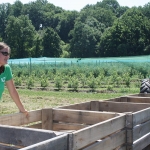
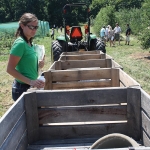
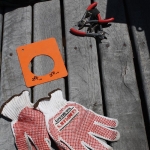
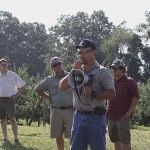
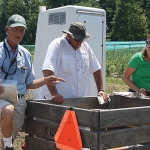





Leave A Comment